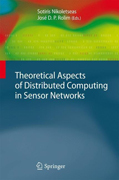
Theoretical aspects of distributed computing in sensor networks
Nikoletseas, Sotiris
Rolim, José
Wireless ad hoc sensor networks has recently become a very active research subject. Achieving efficient, fault-tolerant realizations of very large, highly dynamic, complex, unconventional networks is a real challenge for abstract modelling, algorithmic design and analysis, but a solid foundational and theoretical background seems to be lacking. This book presents high-quality contributions by leading experts worldwide on the key algorithmic and complexity-theoretic aspects of wireless sensor networks. The intended audience includes researchers and graduate students working on sensor networks, and the broader areas of wireless networking and distributed computing, as well as practitioners in the relevant application areas. The book can also serve as a text for advanced courses and seminars. Comprehensive handbook-style treatment Contributions by leading international researchers First complete treatment of the topic INDICE: Theme I – Challenges for Wireless Sensor Networks [1] Composition and Scaling Challenges in Sensor Networks: An Interaction-centric View Theme II – Models, Topology, Connectivity [2] Scheduling and Power Assignments in thePhysical Model [3] Maintaining Connectivity in Sensor Networks Using Directional Antennae [4] Optimal Placement of Ad Hoc Devices Under a VCG-Style RoutingProtocol [5] Population Protocols and Related Models [6] Theoretical Aspects of Graph Models for MANETs [7] Networked Distributed Source Coding Theme III –Localization, Time Synchronization, Coordination [8] The Spatial Smoothing Method of Clock Synchronization in Wireless Networks [9] Algorithmic Aspects of Sensor Localization [10] Spatiotemporal Context in Wireless Sensor Networks [11] Coordination Problems in Ad Hoc Radio Networks Theme IV – Data Propagation and Collection [12] Probabilistic Data Propagation in Wireless Sensor Networks[13] Oblivious Routing for Sensor Network Topologies [14] Scheduling Algorithms for Tree-Based Data Collection in Wireless Sensor Networks [15] Position-Based Routing in Wireless Ad Hoc and Sensor Networks Theme V – Energy Optimization [16] Energy Balanced Data Propagation in Wireless Sensor Networks [17] Dense, Concentric and Nonuniform Multihop Sensor Networks [18] Prolong the Lifetime of Wireless Sensor Networks Through Mobility – A General Optimization Framework Theme VI – Mobility Management [19] Information Spreading in Dynamic Networks – An Analytical Approach [20] Self-stabilizing and Self-organizing VirtualInfrastructures for Mobile Networks [21] Computing by Mobile Robotic Sensors Theme VII – Security Aspects [22] Security and Trust in Sensor Networks [23] Key Management in Sensor Networks [24] Key Predistribution in Wireless Sensor Networks When Sensors Are Within Communication Range Theme VIII – Tools, Applications and Use Cases [25] Realistic Applications for Wireless Sensor Networks [26] High-Level Application Development for Sensor Networks – Data-Driven Approach [27] Towards Integrated Real-World Sensing Environment – Applications andChallenges
- ISBN: 978-3-642-14848-4
- Editorial: Springer
- Encuadernacion: Cartoné
- Páginas: 928
- Fecha Publicación: 01/10/2010
- Nº Volúmenes: 1
- Idioma: Inglés
